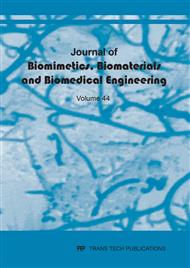[1]
L. I. Rudin, S. Osher, and E. Fatemi, Nonlinear total variation-based noise removal algorithms,, Physica D: Nonlinear Phenomena, vol. 60, no. 1-4, p.259–268, (1992).
DOI: 10.1016/0167-2789(92)90242-f
Google Scholar
[2]
G. Aubert and P. Kornprobst, Mathematical Problems in Image Processing, Partial Differential Equations and the Calculus of Variations, vol. 147 of Applied Mathematical Sciences, Springer Science + Business Media, LLC, New York, NY, USA, 2ndedition, (2006).
DOI: 10.1007/978-0-387-44588-5
Google Scholar
[3]
T. F. Chan and J. Shen, Image Processing and Analysis: Variational, PDE, Wavelet, and Stochastic Methods, Society for Industrial and Applied Mathematics, Philadelphia, PA, USA,(2005).
DOI: 10.1186/1475-925x-5-38
Google Scholar
[4]
J. Xu, A. Feng, Y. Hao, X. Zhang, and Y. Han, Image deblurring and denoising by an improved variational model,, International Journal of Electronics and Communications, vol. 70, no. 9, p.1128–1133, (2016).
DOI: 10.1016/j.aeue.2016.05.008
Google Scholar
[5]
L. Jiang, J. Huang, X.-G. LV, and J. Liu, Alternating direction method for the high-order total variation-based Poisson noise removal problem,, Numerical Algorithms, vol. 69, no. 3, p.495–516, (2015).
DOI: 10.1007/s11075-014-9908-y
Google Scholar
[6]
M. Elad and M. Aharon, Image denoising via sparse and redundant representations over learned dictionaries,, IEEE Transactions on Image Processing, vol. 15, no. 12, p.3736–3745,(2006).
DOI: 10.1109/tip.2006.881969
Google Scholar
[7]
N. Mustafa, J. Ping, S. Ahmed, and M. Giess, Medical image de-noising schemes using wavelet transform with fixed formthresholding,, International Journal of Advanced ComputerScience and Applications, vol. 6, no. 10, p.173–178, (2015).
DOI: 10.14569/ijacsa.2015.061024
Google Scholar
[8]
W. Jifara, F. Jiang, S. Rho, M. Cheng, and S. Liu, Medicalimagedenoising using convolutional neural network: a residual learning approach,, The Journal of Supercomputing, p.1–15,(2017).
DOI: 10.1007/s11227-017-2080-0
Google Scholar
[9]
F. Zhang, N. Cai, J. Wu, G. Cen, H. Wang, and X. Chen, Image denoising method based on a deep convolution neuralnetwork,, IET Image Processing, vol. 12, no. 4, p.485–493, (2018).
DOI: 10.1049/iet-ipr.2017.0389
Google Scholar
[10]
K. Isogawa, T. Ida, T. Shiodera, and T. Takeguchi, Deep shrinkage convolutional neural network for adaptive noise reduction,, IEEE Signal Processing Letters, vol. 25, no. 2, p.224–228, (2018).
DOI: 10.1109/lsp.2017.2782270
Google Scholar
[11]
Liu C, Szeliski R, Kang SB, Zitnick CL, Freeman WT. Automatic estimation and removal of noise from a single image. IEEE Transactions on Pattern Analysis and MachineIntelligence. 2008 Feb; 30(2).
DOI: 10.1109/tpami.2007.1176
Google Scholar
[12]
Anutam, Rajni. Performance analysis of image denoisingwith wavelet thresholding methods for different levels ofdecomposition. The International Journal of Multimediaand Its Applications. 2014 Jun; 6(3).
DOI: 10.5121/ijma.2014.6303
Google Scholar
[13]
A. Piˇzurica, W. Philips, I. Lemahieu, and M. Acheroy, Despeckling SAR images using wavelets and a new class of adaptive shrinkage functions,, Proc. IEEE Internat. Conf. on Image Proc., ICIP 2001, Thessaloniki, Grece, Oct (2001).
DOI: 10.1109/icip.2001.958467
Google Scholar
[14]
A. Buades, B. Coll, and J Morel.On image denoising methods.Technical Report 2004- 15, CMLA, (2004).
Google Scholar
[15]
A. Buades, B. Coll, and J Morel.A non-local algorithm for image denoising.IEEE International Conference on Computer Vision and Pattern Recognition, (2005).
DOI: 10.1109/cvpr.2005.38
Google Scholar
[16]
A. Foi and G. Boracchi, Foveated self-similarity in nonlocal image filtering,, in SPIE Human Vision and Electronic Imaging XVII, vol. 8291. Burlingame, California, USA: SPIE, (2012).
DOI: 10.1117/12.912217
Google Scholar
[17]
A. Buades, B. Coll, and J. Morel, A review of image denoising algorithms, with a new one,, Multiscale Modeling Simulation, vol. 4, no. 2, p.490, (2005).
DOI: 10.1137/040616024
Google Scholar


